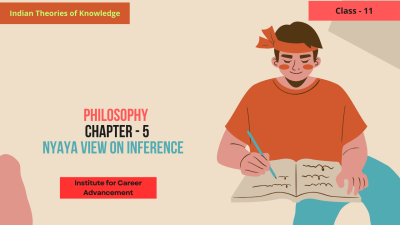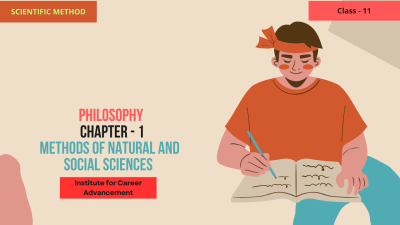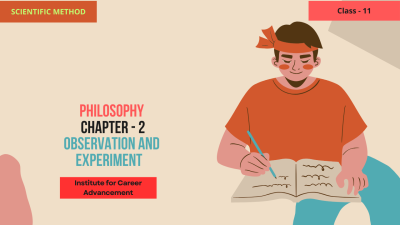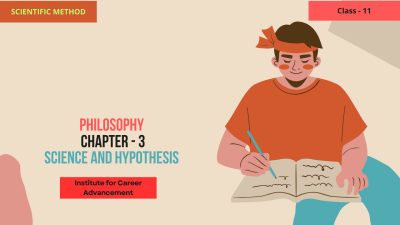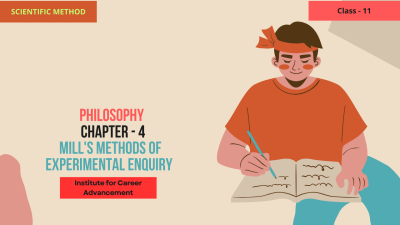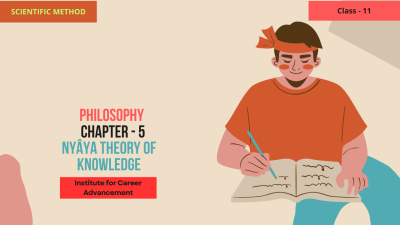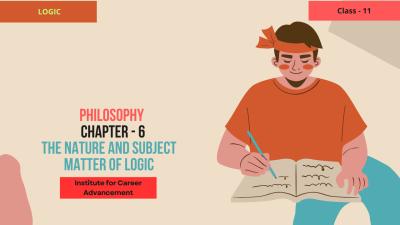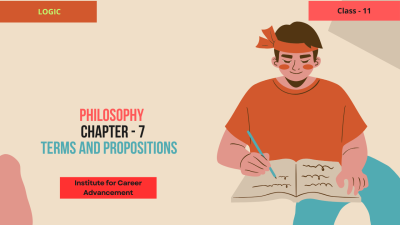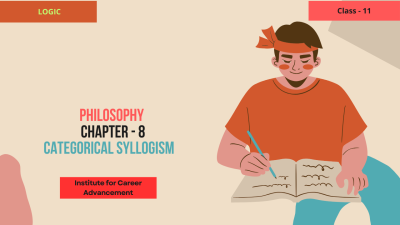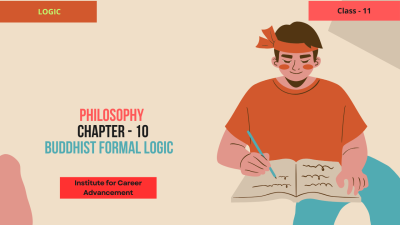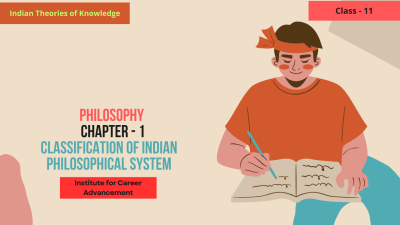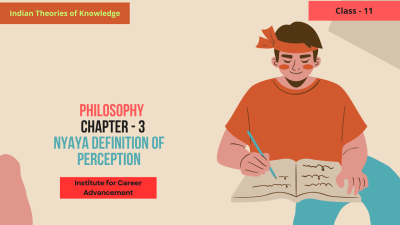Course description
The Nyaya school of philosophy plays a significant role in Indian epistemology by focusing on the means of acquiring knowledge (pramāṇas). One of the primary methods of knowledge, according to Nyaya, is inference (anumāna). The Class 11 course on the Nyaya View on Inference explores how inference serves as a reliable source of knowledge and the method by which humans arrive at conclusions based on logical reasoning and evidence.
This topic provides students with an understanding of how Nyaya philosophers conceptualized inference as a process of deriving knowledge from what is already known, and how this method compares with other epistemological tools like perception (pratyakṣa).
1. Introduction to the Nyaya School of Philosophy
Objective: Students will be introduced to the Nyaya school, one of the six classical schools of Indian philosophy, which focuses on logic, reasoning, and the methods of obtaining valid knowledge.
Key Points:
Nyaya: Emphasizes pramāṇas (valid means of knowledge), which include perception, inference, comparison, and testimony.
Inference: This method is central in Nyaya, where knowledge is derived through logical reasoning and evidence.
Connection to logic: The Nyaya school is closely tied to the development of formal logic and argumentation in ancient India.
2. Understanding Inference (Anumāna)
Objective: Students will explore the concept of inference (anumāna) as defined by Nyaya philosophers, learning its various forms and applications.
Key Points:
Definition of Inference: Inference is the process of deriving knowledge about something that is not directly perceived based on what is already known or perceived.
Elements of Inference: Nyaya philosophers break inference into key components:
Pratijñā (Proposition or Thesis): The statement or conclusion that is being made.
Hetu (Reason or Cause): The evidence or reason that supports the proposition.
Drṣṭānta (Example): The example that illustrates the reasoning.
Conclusion (Sādhyā): The inferred truth that follows from the evidence and example.
3. The Five Types of Inference in Nyaya
Objective: Students will learn about the five types of inference described by Nyaya philosophers, which represent different ways of using inference to derive knowledge.
Key Points:
Sabhāva (inference for inherent qualities): Inference based on the natural or inherent qualities of an object.
Vyāpti (inference for universal connection): Inference based on the relationship between properties that always occur together.
Ālambana (inference based on support): Inference based on something that supports a particular feature.
Anupalabdhi (inference based on non-apprehension): Inference drawn from the absence of a specific perception.
Pratibhā (inference based on immediate recognition): Inference from immediate recognition without full observation.
4. The Logical Structure of Inference
Objective: Students will delve into the logical structure of an inference as articulated by Nyaya and understand how valid inference is constructed.
Key Points:
Example:
"The hill is on fire because smoke is rising from it."
Pratijñā: The hill is on fire.
Hetu: Smoke is rising from the hill.
Drṣṭānta: It is well-known that wherever there is smoke, fire is present.
Conclusion: Therefore, the hill must be on fire.
Nyaya’s system of reasoning emphasizes the importance of valid premises (evidence) and the logical connection between the reason and the conclusion.
5. Types of Inference-Based Arguments:
Objective: Students will examine how Nyaya uses inference in structured debates and arguments, focusing on how valid and invalid inferences are distinguished.
Key Points:
Valid vs. Invalid Inference: Nyaya logic distinguishes between valid inferences (where the reason supports the conclusion) and invalid inferences (where the reason does not logically support the conclusion).
Fallacies: Students will learn about logical fallacies (errors in reasoning) that arise when inferences are incorrectly made.
Summary
In this unit, Class 11 students will explore the Nyaya view on inference and how it plays a central role in logical reasoning and the acquisition of knowledge. Key aspects include:
The components of inference.
The five types of inference according to Nyaya.
The logical structure and application of inference in daily life and philosophical debate.
Comparison with other schools of Indian philosophy.
By understanding the Nyaya view on inference, students will gain a deeper insight into the logical reasoning that is essential in both philosophical discussions and practical decision-making.
জ্ঞান অর্জনের উপায়গুলিতে মনোনিবেশ করে ভারতীয় জ্ঞানতত্ত্বে দর্শনের ন্যায় স্কুল একটি গুরুত্বপূর্ণ ভূমিকা পালন করে (প্রমাণ) ন্যায় অনুসারে, জ্ঞানের প্রাথমিক পদ্ধতিগুলির মধ্যে একটি হল অনুমান (অনুমানা)। অনুমানের উপর ন্যায় দৃষ্টিভঙ্গির উপর একাদশ শ্রেণির কোর্সটি অনুসন্ধান করে যে কীভাবে অনুমান জ্ঞানের একটি নির্ভরযোগ্য উৎস হিসাবে কাজ করে এবং যে পদ্ধতি দ্বারা মানুষ যৌক্তিক যুক্তি এবং প্রমাণের ভিত্তিতে সিদ্ধান্তে পৌঁছায়। এই বিষয়টি শিক্ষার্থীদের বোঝায় যে কীভাবে ন্যায় দার্শনিকরা ইতিমধ্যেই যা জানা গেছে তা থেকে জ্ঞান অর্জনের প্রক্রিয়া হিসাবে অনুমানের ধারণা দিয়েছিলেন এবং কীভাবে এই পদ্ধতিটি অন্যান্য জ্ঞানতাত্ত্বিক সরঞ্জামগুলির সাথে তুলনা করে যেমন উপলব্ধি (প্রত্যক্ষা) 1টি। ন্যায় দর্শনশাস্ত্রের ভূমিকা উদ্দেশ্যঃ শিক্ষার্থীদের ভারতীয় দর্শনের ছয়টি ধ্রুপদী বিদ্যালয়ের মধ্যে একটি ন্যায় বিদ্যালয়ের সাথে পরিচয় করিয়ে দেওয়া হবে, যা যুক্তি, যুক্তি এবং বৈধ জ্ঞান অর্জনের পদ্ধতির উপর দৃষ্টি নিবদ্ধ করে। মূল বিষয়গুলোঃ ন্যায়ঃ প্রমাণের (জ্ঞানের বৈধ মাধ্যম) উপর জোর দেয় যার মধ্যে উপলব্ধি, অনুমান, তুলনা এবং সাক্ষ্য অন্তর্ভুক্ত। অনুমানঃ এই পদ্ধতিটি ন্যায়ের কেন্দ্রবিন্দু, যেখানে যুক্তিসঙ্গত যুক্তি এবং প্রমাণের মাধ্যমে জ্ঞান অর্জন করা হয়। যুক্তির সঙ্গে সংযোগঃ প্রাচীন ভারতে আনুষ্ঠানিক যুক্তি ও যুক্তির বিকাশের সঙ্গে ন্যায় মতবাদ ঘনিষ্ঠভাবে জড়িত। 2. অনুমান বোঝা (অনুমানা) উদ্দেশ্যঃ শিক্ষার্থীরা ন্যায় দার্শনিকদের দ্বারা সংজ্ঞায়িত অনুমানের (অনুমানা) ধারণাটি অন্বেষণ করবে, এর বিভিন্ন রূপ এবং প্রয়োগগুলি শিখবে। মূল বিষয়গুলোঃ অনুমানের সংজ্ঞাঃ অনুমান হল এমন কিছু সম্পর্কে জ্ঞান অর্জনের প্রক্রিয়া যা ইতিমধ্যে পরিচিত বা অনুভূত কিছুর উপর ভিত্তি করে সরাসরি অনুভূত হয় না। অনুমানের উপাদানঃ ন্যায় দার্শনিকরা অনুমানকে মূল উপাদানগুলিতে বিভক্ত করেছেনঃ প্রতিজনা (প্রস্তাবনা বা থিসিস) যে বিবৃতি বা উপসংহার তৈরি করা হচ্ছে। হেতু (কারণ বা কারণ) প্রমাণ বা কারণ যা প্রস্তাবটিকে সমর্থন করে। দৃষ্টান্ত (উদাহরণ) যুক্তি ব্যাখ্যা করে এমন উদাহরণ। উপসংহার (সাধনা) প্রমাণ এবং উদাহরণ থেকে প্রাপ্ত অনুমিত সত্য। 3. ন্যায়ের পাঁচ ধরনের অনুমান উদ্দেশ্যঃ শিক্ষার্থীরা ন্যায় দার্শনিকদের দ্বারা বর্ণিত পাঁচ ধরনের অনুমান সম্পর্কে শিখবে, যা জ্ঞান অর্জনের জন্য অনুমান ব্যবহারের বিভিন্ন উপায়ের প্রতিনিধিত্ব করে। মূল বিষয়গুলোঃ সভাভা (অন্তর্নিহিত গুণাবলীর জন্য অনুমান) কোনও বস্তুর প্রাকৃতিক বা অন্তর্নিহিত গুণাবলীর উপর ভিত্তি করে অনুমান। ব্যপ্তি (সর্বজনীন সংযোগের জন্য অনুমান) সর্বদা একসাথে ঘটে যাওয়া বৈশিষ্ট্যগুলির মধ্যে সম্পর্কের উপর ভিত্তি করে অনুমান। আলম্বন (সমর্থনের উপর ভিত্তি করে অনুমান) একটি নির্দিষ্ট বৈশিষ্ট্যকে সমর্থন করে এমন কিছুর উপর ভিত্তি করে অনুমান। অনুপলব্ধি (অজ্ঞতার উপর ভিত্তি করে অনুমান) একটি নির্দিষ্ট উপলব্ধির অনুপস্থিতি থেকে নেওয়া অনুমান। প্রতিভা (তাৎক্ষণিক স্বীকৃতির উপর ভিত্তি করে অনুমান) সম্পূর্ণ পর্যবেক্ষণ ছাড়াই তাৎক্ষণিক স্বীকৃতি থেকে অনুমান। 4. অনুমানের যৌক্তিক কাঠামো উদ্দেশ্যঃ শিক্ষার্থীরা ন্যায় দ্বারা বর্ণিত একটি অনুমানের যৌক্তিক কাঠামো অনুসন্ধান করবে এবং বুঝতে পারবে যে কীভাবে বৈধ অনুমান তৈরি করা হয়। মূল বিষয়গুলোঃ উদাহরণঃ "পাহাড়টিতে আগুন লেগেছে কারণ সেখান থেকে ধোঁয়া উঠছে।" প্রতিজনঃ পাহাড়ে আগুন জ্বলছে। হেতুঃ পাহাড় থেকে ধোঁয়া উঠছে। দৃষ্টিঃ এটা সর্বজনবিদিত যে, যেখানেই ধোঁয়া থাকে, সেখানে আগুন থাকে। উপসংহারঃ অতএব, পাহাড়ে অবশ্যই আগুন লেগে থাকতে হবে। ন্যায়ের যুক্তি পদ্ধতি বৈধ ভিত্তি (প্রমাণ) এবং কারণ ও উপসংহারের মধ্যে যৌক্তিক সংযোগের গুরুত্বের উপর জোর দেয়। 5. অনুমান-ভিত্তিক যুক্তির প্রকারঃ উদ্দেশ্যঃ শিক্ষার্থীরা পরীক্ষা করবে যে কীভাবে ন্যায় কাঠামোগত বিতর্ক এবং যুক্তিতে অনুমান ব্যবহার করে, কীভাবে বৈধ এবং অবৈধ অনুমানগুলি আলাদা করা হয় তার উপর দৃষ্টি নিবদ্ধ করে। মূল বিষয়গুলোঃ বৈধ বনাম। অবৈধ অনুমানঃ ন্যায় যুক্তি বৈধ অনুমান (যেখানে কারণটি উপসংহারকে সমর্থন করে) এবং অবৈধ অনুমানের (যেখানে কারণটি যৌক্তিকভাবে উপসংহারকে সমর্থন করে না) মধ্যে পার্থক্য করে। ভুল ধারণাঃ শিক্ষার্থীরা যৌক্তিক ভুল (যুক্তিতে ত্রুটি) সম্পর্কে শিখবে যা ভুলভাবে অনুমান করা হলে উদ্ভূত হয়। সারসংক্ষেপ এই ইউনিটে, একাদশ শ্রেণির শিক্ষার্থীরা অনুমানের উপর ন্যায়ের দৃষ্টিভঙ্গি এবং কীভাবে এটি যৌক্তিক যুক্তি এবং জ্ঞান অর্জনে কেন্দ্রীয় ভূমিকা পালন করে তা অন্বেষণ করবে। মূল বিষয়গুলির মধ্যে রয়েছেঃ অনুমানের উপাদানসমূহ। ন্যায় অনুসারে পাঁচ ধরনের অনুমান। দৈনন্দিন জীবন এবং দার্শনিক বিতর্কে অনুমানের যৌক্তিক কাঠামো এবং প্রয়োগ। ভারতীয় দর্শনের অন্যান্য ধারার সঙ্গে তুলনা। অনুমানের উপর ন্যায়ের দৃষ্টিভঙ্গি বোঝার মাধ্যমে, শিক্ষার্থীরা দার্শনিক আলোচনা এবং ব্যবহারিক সিদ্ধান্ত গ্রহণ উভয়ের ক্ষেত্রেই প্রয়োজনীয় যৌক্তিক যুক্তি সম্পর্কে গভীর অন্তর্দৃষ্টি অর্জন করবে।

